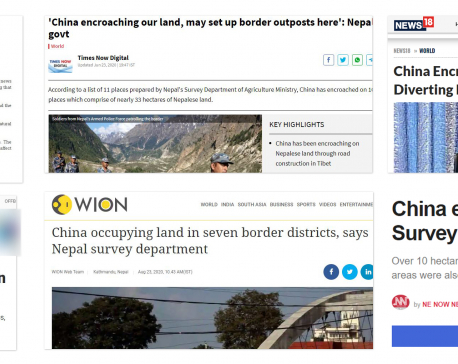
OR
China not to alter course of rivers flowing into Nepal
Published On: January 24, 2020 07:30 AM NPT By: Kosh Raj Koirala | @KoshRKoirala
KATHMANDU, Jan 24: China has agreed not to deliberately change or cause to change the course of any trans-boundary rivers flowing into Nepal. This comes under an Agreement on the Boundary Management System reached with Nepal during the visit of Chinese President Xi Jinping to Kathmandu in October.
All the major rivers including the Karnali, Kali Gandaki, Budhi Gandaki, Trishuli, Sunkoshi, Bhotekoshi, Tamakoshi and Arun originate in the Tibet Autonomous Region (TAR) of China. Nepal as well as the northern part of India could be seriously affected if any dams or diversion projects are built in upper riparian Tibet. Many hydropower projects and irrigation works downstream would be directly impacted if there is any reduction in water level in these snow-fed rivers.
Nepal and China have agreed to solve through cooperation the issues of utilizing and protecting cross-border rivers on the basis of the principle of equality and mutual benefit and without causing any loss to the other side. “Both sides shall, as far as possible, prevent the boundary rivers from changing their courses. Neither side shall deliberately change or cause to change the course of any boundary river,” states Article 7 (1) of the Agreement.
The agreement between Nepal and China has a huge bearing on India also. According to a study report published in 2009, some 46 percent of the flow in the Ganga River in India comes through major rivers in Nepal and their contribution grows to over 70 percent during the lean season.
The agreement also comes amid several media reports suggesting that China is planning a 1,000 km tunnel to divert Brahmaputra River waters to parts of Tibet and to Xinjiang in its northwestern region. The purported plan has left India nervous as it could significantly reduce the river flows into India.
\As per their agreement, Nepal and China shall have the right of utilizing cross-border waters without affecting the existing use and future needs, while also agreeing to take measures to protect the ecology and environment of such waters. “In case a boundary river changes its course, necessary measures shall be taken by both sides or after mutual Agreement, by either side, to restore the boundary river to its original course,” reads Article 7(3) of the Agreement.
The two countries have agreed to keep the section of the boundary line unchanged on both sides in the absence of any other agreement in case a boundary river cannot be restored to its original course owing to natural causes. The agreement comes in the context of Nepal facing border disputes with India after rivers that served as boundaries with that country changed course over the years. A case in point is Susta village in Nawalparasi district.
Government officials are optimistic that the agreement to follow a ‘fixed boundary principle’ that Nepal has reached with China could help settle some of the most outstanding border disputes with the southern neighbor as well.
The Agreement on Boundary Management System makes it mandatory for both the countries to inform the other side in advance if they are engaging in any industrial, agricultural, forestry or mining pursuits in the vicinity of the boundary line. “Construction, administration and maintenance of the cross-border facilities are subject to consensus through consultation of both sides or the competent authorities of both sides,” reads Article 10 (1).
The Nepali side last year voiced concern after the Arun River began changing its course in the Kimathanka area of Sakhuwasabha district after the Chinese side started constructing an embankment along the river on its side of the border without informing Nepal in advance. Locals in Kimathanka village had felt threatened that the construction work could inundate their entire village during the rainy season.
Among other things, Nepal and China have agreed to set up a Nepal-China Border Joint Inspection Committee in order to carry out joint inspections, repairs, reconstruction and re-erection of boundary markers. The committee will determine the principles, procedures and modalities for the border inspection tasks.
You May Like This

The fault lines of Indian regionalism
Although India is competing with China by investing in connectivity in the region, it has not fully embraced economic openness.... Read More...

Nepalis surprised by Indian media’s repeated romance with fake Nepal-China border dispute
KATHMANDU, Aug 25: Social media users as well as others in Nepal are taken by surprise as Indian media outlets appear... Read More...

Sept 24: 6 things to know by 6 PM today
Your daily dose of missed important news of the day. ... Read More...







Just In
- NRB to provide collateral-free loans to foreign employment seekers
- NEB to publish Grade 12 results next week
- Body handover begins; Relatives remain dissatisfied with insurance, compensation amount
- NC defers its plan to join Koshi govt
- NRB to review microfinance loan interest rate
- 134 dead in floods and landslides since onset of monsoon this year
- Mahakali Irrigation Project sees only 22 percent physical progress in 18 years
- Singapore now holds world's most powerful passport; Nepal stays at 98th











Leave A Comment